Chen Kao-teng (陳高登) communicates with the objects he repairs — whether bowls, plates or teapots, he doesn’t discriminate. Chen does so, he says, because it’s the best way to channel his creativity, a lesson he learned from his mentor Lai Chih-hsien (賴志賢).
He would later discover that the process made him reapproach his attitude towards the polio he has had since he was a child.
“Lai taught me how to talk to the objects,” he says. “We think that as craftsmen we can do whatever we please with an object, but objects have souls.”
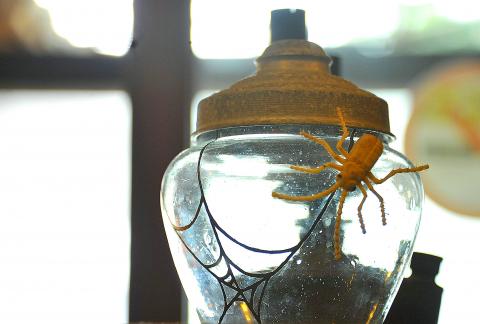
Photo: Han Cheung, Taipei TImes
Chen, 52, is among a handful of craftspeople in Taiwan who earns a living repairing and repurposing broken, discarded and imperfect objects using the traditional craft of ceramic repair called juci (焗瓷).
The trade thrived during the Japanese colonial period when even the ritzy hotel Kangsanlau (江山樓) used plates during banquets that had been stapled together. It declined in the 1960s as the nation’s economy took off, while restaurants started using disposable plates and stores began selling NT$200 shoes. He also learned the Japanese art of kintsugu, which uses resin and gold or silver dust to fill cracks.
It wasn’t until 2013 that Chen and Lai received formal training from Chinese master Wang Laoxie (王老邪). Wang began his apprenticeship at the age of four as the grandson of a court repair craftsman for the Qing Empire.
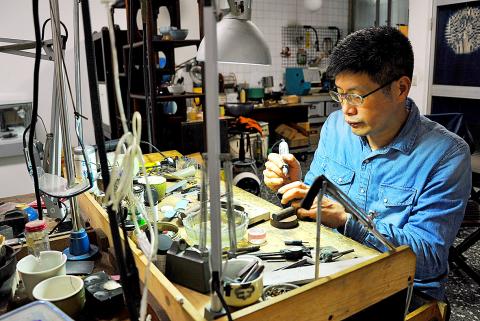
Photo: Han Cheung, Taipei TImes
Since juci was dormant for decades, even “specialists” like Chen are relative newcomers. Originally a metalsmith, Chen accidentally discovered the craft while researching ways to fix a friend’s teapot. While Chen sought out Lai as the authority on juci for his Master’s thesis, Lai insists that he was no expert and only gleaned what he could by taking apart repaired antiques.
POLIO AND PERFECTION
In his studio, Chen motions towards the metal staples in a teapot. He tells me how they remind him of the numerous surgeries to correct the imperfections polio wrought on his childhood body.
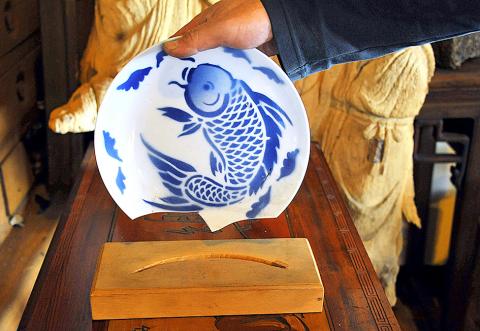
Photo: Han Cheung, Taipei TImes
“Life isn’t perfect... But we can still find a way to repair things,” Chen says.
He came to this realization six years ago when he started to practice juci.
“I initially thought I was just making the damaged part look prettier,” he says. “But I realized I was also channeling my thoughts and feelings into the process. I started being less conscious about my disability, which I used to hide from everyone.”
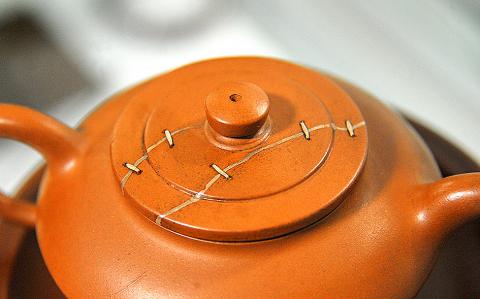
Photo: Han Cheung, Taipei TImes
In other words, perfection isn’t all it’s cracked up to be. Sometimes just because something is broken doesn’t mean it doesn’t have value.
“A person’s sentimental attachment to an object isn’t going to disappear just because they can afford something new,” Chen says. “[Some objects are] irreplaceable not only because of the customer’s emotional attachment to it, but also because another might not exist.”
Chen says most of his customers today bring him objects that have sentimental value — a family heirloom, for example, or a favorite pipe. At the prohibitive price of NT$2,000 to NT$3,000, fixing any old teapot wouldn’t make financial sense.
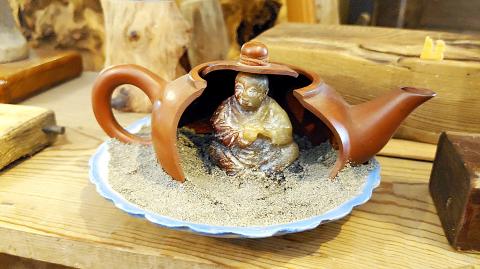
Photo: Han Cheung, Taipei TImes
Chen says there’s been a surge of interest in his skill due to an increased awareness of sustainability, reducing waste and green living, but there’s only a handful of artisans doing it for a living.
“I want people to think before they discard,” Lai says.
KEEPING AN OLD TRADE RELEVANT
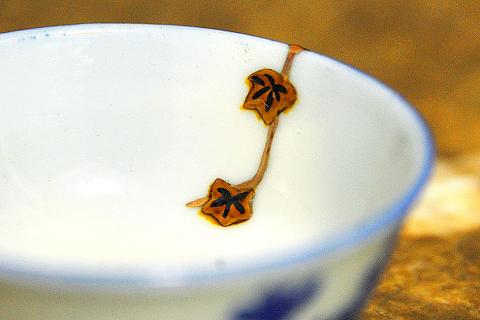
Photo: Han Cheung, Taipei TImes
Since traditional repairs are no longer a necessity, Chen and Lai say creativity keeps the trade relevant, from stapling a split tabletop in a way that resembles a flower to repurposing a broken teapot into an oil lamp and incense burner. Instead of restoring something to its original form, they breath new life and value into formerly defective objects, Lai says.
Lai takes his creativity a step further, often whimsically repurposing broken objects rather than mending them. There’s a clock in his shop adorned with pieces from a bowl too broken to mend, and a cup with a smashed bottom, turned candle holder.
GENERATING INTEREST
Chen has a small but steady supply of students at his studio or at the Beitou Museum (北投文物館), a restored Japanese residence near the hot springs. Most of the students are retirees or collectors of teapots or antiques, but there’s also a few younger ones. Chen has simplified and modified the procedures so they are more accessible to the average learner.
“If a carpenter comes, I’ll teach him how to fix things with wood so it’s easier for him. The point is the concept. Juci is more than just the staples.”
In Chen’s studio, Yeh Chih-chin (葉志錦) is learning to fix a favorite teapot and a crudely superglued cup his daughter brought back from Yellowstone National Park. Meanwhile, Huang Chen-yu (黃貞毓) is working on her father’s teapot and her father’s friend’s pipe. Both are career artists, Yeh a sculptor and Huang a jewelry maker.
“I like learning different crafts and my dad and his friend happened to have a bunch of stuff they wanted to repair,” Huang says. She doesn’t think the repair trade is dying out, but it’s becoming a niche skill that the average person isn’t likely familiar with.
Chen says the craft needs to be connected to something relevant and commercially viable, such as the tea industry or the trending Japanese wabisabi design aesthetics that focus on the beauty of imperfection.
And people are also looking to commercially bank on the “retro” feel of repaired objects. One of Chen’s students is a sushi chef who once went to a Japanese restaurant that served its food on elegantly repaired kintsugi plates. He wants to learn the skills from Chen to recreate that experience in his future restaurant.
Meanwhile in another part of the workshop, Lai points to a cracked plaque on the wall showing a Hoklo (also known as Taiwanese) idiom in Chinese characters: “Everything is fine.”
“I was going to repair this. But it kept telling me ‘everything is fine.’ So I just left it as it is and framed it,” he laughs.

In recent weeks the Trump Administration has been demanding that Taiwan transfer half of its chip manufacturing to the US. In an interview with NewsNation, US Secretary of Commerce Howard Lutnick said that the US would need 50 percent of domestic chip production to protect Taiwan. He stated, discussing Taiwan’s chip production: “My argument to them was, well, if you have 95 percent, how am I gonna get it to protect you? You’re going to put it on a plane? You’re going to put it on a boat?” The stench of the Trump Administration’s mafia-style notions of “protection” was strong
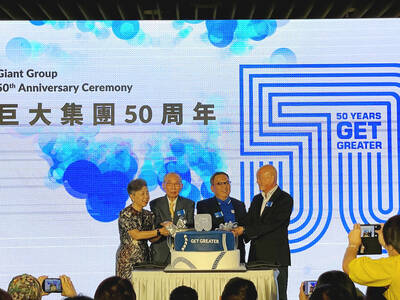
Late last month US authorities used allegations of forced labor at bicycle manufacturer Giant Group (巨大集團) to block imports from the firm. CNN reported: “Giant, the world’s largest bike manufacturer, on Thursday warned of delays to shipments to the United States after American customs officials announced a surprise ban on imports over unspecified forced labor accusations.” The order to stop shipments, from the US Customs and Border Protection (CBP), came as a surprise to Giant, company officials said. Giant spokesman Ken Li (李書耕) said that the CPB never visited the company’s factories to conduct on-site investigations, nor to interview or

Every now and then, it’s nice to just point somewhere on a map and head out with no plan. In Taiwan, where convenience reigns, food options are plentiful and people are generally friendly and helpful, this type of trip is that much easier to pull off. One day last November, a spur-of-the-moment day hike in the hills of Chiayi County turned into a surprisingly memorable experience that impressed on me once again how fortunate we all are to call this island home. The scenery I walked through that day — a mix of forest and farms reaching up into the clouds
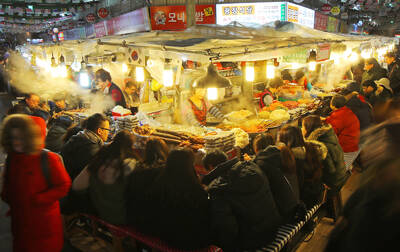
“Eighteen years ago, people didn’t even know the name of this ingredient,” says 58-year-old Gil Sa-hyeon, holding up a cluster of dried brownish stems. “Now it’s everywhere.” His shop, Joseon Yakcho, sits in the heart of Seoul’s Yangnyeongsi Market, South Korea’s largest traditional medicinal herb market, its streets lined with shops displaying buckets of herbs such as licorice root and cinnamon bark that spill on to the pavements, filling the air with their distinct, earthy aroma. The ingredient Gil is referring to is hovenia dulcis, known in Korean as heotgae — the oriental raisin tree that’s become the cornerstone of South Korea’s